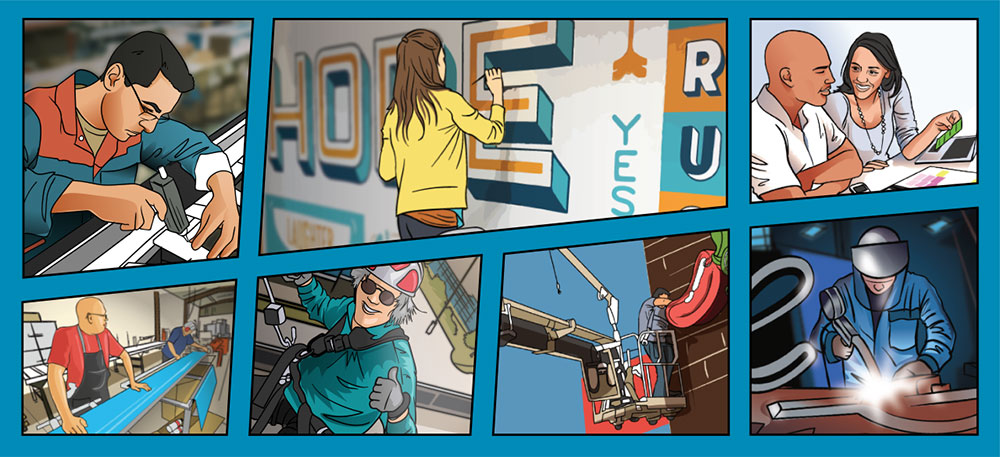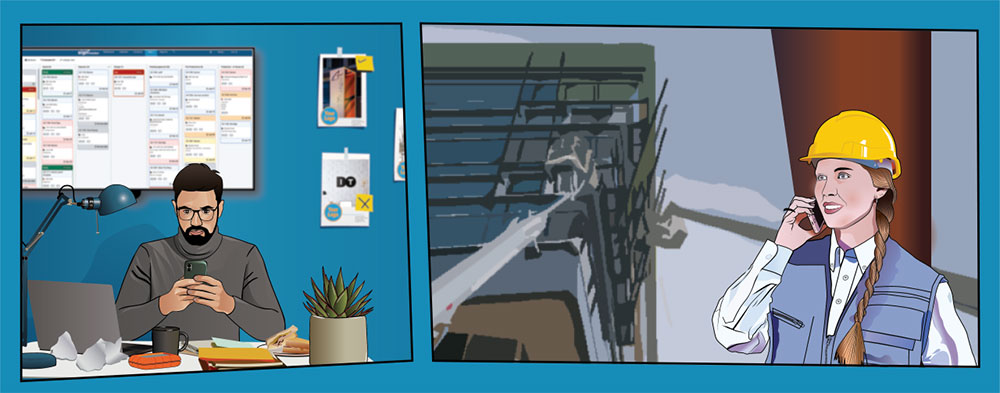
Large sign projects can be complicated and can veer off track quickly without proper planning. Just like construction planning, sign projects follow a very similar path. From the initial meeting with the client to the last sign being installed, each step is critical to a successful and profitable project.
I would like to say that every sign project I have sold went off without a hitch, but I would be lying.
Over the years, though, it did become a little easier when I followed some pretty simple steps, which I will now spell out for you in the following “five stages of sign project management.”
#1. Initial Discovery: Simple Questions Can Change Everything.
Start every sign project by listening—not necessarily to what the client thinks should happen to solve their sign needs (that can get everyone in trouble) but rather to what the client is really trying to achieve.
Do they want the biggest sign on the city skyline? Or do they want to create a sense of serenity in their retirement community development?
Once you have asked the right questions, you and your team will have an understanding of the client’s goals. Then you can start to work on solutions.
The initial discovery phase of the project can be long and complex so be sure to communicate to your client the importance of not rushing this process. If you are thorough in this first phase, you will avoid costly mistakes—as well as disappointed clients—down the line.
Start with a call or meeting with the city planner to determine what is permissible in the code.
While this is not an exhaustive list, here are some things to consider during this meeting:
- Is what your client trying to achieve permittable?
- Will the permit require a variance?
- Are you going to need the building’s architectural drawings in order to determine the best mounting methods for your permit drawings?
- Does the sign project require sealed engineering drawings?
- Will there be street access for large cranes and lifts?
- Are there any weight restrictions when parking a crane in a street or alley way (think old city grease traps—you don’t want your crane to collapse into a sinkhole)?
- Will power lines need to be removed?
- Are you going to need street and sidewalk closure permits?
- Will you need to hire police to direct traffic?
- Does your install team require on-site safety training?
- Will the project require an additional insurance rider?
While this might seem like a daunting list—and I am sure I probably missed an item or two—these are the types of issues that need to be determined before you can start any large sign project.
#2. Planning: Details Will Make or Break Your Job’s Profit.
Once you are past the initial discovery phase, you are ready to start to develop a plan on how the project will actually get completed.
If you have not done so already, perform a final technical survey of the site. This should be conducted by an experienced installer to ensure that the correct details can be communicated to both your design and fabrication team.
This will also result in the signs leaving the shop with correct install patterns, mounting clips, and equipment needed to install the signs. I cannot tell you how many times I have heard installers complain about incorrect mounting patterns being sent to jobsites, leaving them unable to install the signs.
Once you have these details worked out, you can gather your pricing to produce accurate quotes. Materials will need to be researched for availability and cost. Plus the labor needed to design, permit, fabricate, and install will need to be calculated, along with any other incidentals that you have discovered in the initial phase of the project.
Final designs, quotes, and timelines can now be presented to the client for approval. Please make sure you have already received a deposit for your initial discovery work and designs (approximately 10 percent of the value of the project).
When quoting large projects, never be vague. Always outline in accurate detail what the quote covers. After all, large projects often have change orders, and you do not want to fall victim to scope creep (defined as “changes, continuous, or uncontrolled growth in a project’s scope at any point after the project begins”) and get stuck with the bill.
#3. Ensuring Near-perfect Execution: Engage Your Team.
One mistake that I made as a sign shop owner was to assume that everyone involved knew what I knew about the steps needed to complete the project. I quickly learned that, every time I tried to do it all, I dropped the ball. When I was willing to make large projects a team effort, everything ran much smoother.
Host a kickoff meeting with your team to create a list of tasks and determine who will be responsible for each task. It is helpful to work backwards from the project’s due date, so you can plan the scheduling of each task.
When you are done with this phase of planning the project, you should have a clear picture of who is responsible for each task, which suppliers you will be using for materials or wholesaler manufacturers for signs you are outsourcing, install crew schedule, equipment needed, and budgets set.

#4. Monitoring the Project: How to Avoid 90 Percent of the Mistakes.
Hold weekly team production meetings to make sure project milestones are being met.
My shop held production meetings two days per week. Monday after lunch was our big meeting for the week. Here we would go over every job, review all open tasks, and address the items and issues that were blocking jobs from moving forward. On Thursday morning, we held a shorter meeting where we again discussed any problems or blocks on projects.
While this schedule worked well for us, we also communicated in between these meetings, if any problems arose. Project managers, sales reps, and designers would always make themselves available to the fabrication and install team to clarify any questions.
From initial designs to the final sign being installed, we never lost sight of the fact that it takes the whole team to achieve success.
#5. Close the Project: Customer Satisfaction Leads to More Jobs.
Once final signs are installed, it is time to close the project.
Call the client and make sure they are 100 percent satisfied with the results. Address any concerns, and if there are any punch list concerns, correct them in a timely manner.
Make sure you have a system in place to manage the final tasks and that you have stored all important project documents, designs, and photos for future reference, if needed. It is easy to get busy with the next big project and not close out jobs correctly.
Finally make sure to thank your client! Our shop always sent out the final invoice with completion photos and a “thank you” note signed by several staff people. It was a nice touch and usually helped us get paid on time.
You’ve Got This!
As you perfect your planning process and build trusted relationships with your clients, the scope of your projects may become more complex.
Do not shy away from large, complicated projects—they can be fun and profitable. Plus they allow you to build a large portfolio and create a sense of pride and accomplishment with your team.
 You may feel a little uncomfortable to start, but if you stretch yourself, you and your team will watch great things happen!
You may feel a little uncomfortable to start, but if you stretch yourself, you and your team will watch great things happen!
Joe Arenella is the co-founder of SignTracker and the founder of the Behind the Signs facebook group and YouTube channel.










